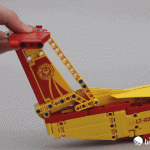Each time LEGO comes out with a new wave of any theme, there tends to be a sort of “flagship” model of the series. These are often large, top-dollar builds that makes every fan drool. But there are actually a lot of models that stand in the shadows as diamonds in the rough. LEGO Technic 42152 Firefighter Aircraft might just be one of those sets. The 1134-piece plane is currently available and retails for US $99.99 | CAN $129.99 | UK £94.99. Come along as we check out all the cool features.
Unboxing the parts, instructions, and sticker sheet
There is nothing particularly exciting about the box, though it does a good job of showcasing some of the features. Soon we’ll see that it’s deceptively small.
The set consists of eleven polybags, numbered 1-4, as well as three 3-19 Technic beams.
The sticker sheet has eleven stickers, but a few are larger and none are annoying to place.
The build
We kick off the build process with our first mechanism: a gear rack slide with a rubber band trigger.
There are no brand-new molds in this set, however, there are a handful of fairly new and rare pieces. Also, this is the first time the 1×7 perpendicular beam has been seen in red.
A rainbow of gears sits inside the center of the plane. They are sandwiched between a couple of giant 3×19 Technic frames and play a part in the rotor mechanism.
A longer perpendicular beam sits above them and slides on along an axel. This is part of the landing gear mechanism.
Next up is a small subassembly that will sit above the previous assembly. This includes a small gear and beefed-up axles.
One of which forms a linkage with the perpendicular beam. The other transfers the motion from the gearbox out toward the wings.
Another linkage is created for the front landing gear wheel. In the GIF below you can see how the mechanism works before it is attached to the rest of the model. A small actuator element is attached to this and will play a large role in the function of the landing gear.
At this point, the front and back assemblies are combined together.
Here you can see how the actuator controls the front wheel. But this actuator is also linked to the rest of the mechanism, which will ultimately allow all the landing gear wheels to move at the same time.
With the central mechanism completed, it’s time to start work on the body of the plane.
We begin with the sides, which is also where we start to see the stickers come into play. Overall, they’re fairly minimal, which is nice.
The back end is built upon the foundation of another 3×19 frame, making the overall plane exceptionally sturdy.
Behind the primary mechanism sits the area where the “water” bricks are stored. The hatch is opened via a lever on the side, and a spring provides tension to keep it both open and closed.
Then we cap it off with some rounded panels for the roof.
The front uses a nice combination of curved panels and flexible axles to create the right shape. The yellow curved panels on the crown of the plane are a newer element and are seen here for the first time in yellow. They’re also used as headlights in the new LEGO Technic 42154 2022 Ford GT.
Moving to the opposite end, the largest stickers are found on the tail. The design is nicely done though and blends in well. This assembly is mounted at an angle simply by pinning it in place while it rests upon the elements below it.
Then we add the side panels that make up the rear, and we cap it off with some more curved panels.
There is a top hatch for the 2×2 round bricks that represent the water. Friction pins are used so that the doors feel sturdy and are not just floppy.
After the doors, we move back to the tail. A linkage of beams connects the tail wing elevators to the body of the plane. I’m on the fence regarding how I feel about this feature. Having the elevators move is great, and the linkage fills out the shape, but it feels a little odd to have this beam floating out there. I think it might’ve been better (albeit using more pieces) if this feature was accomplished the same as the primary wings, which you’ll see in a moment.
From the tail, we move to the wing landing gear and the mechanism for the propellers.
Before we complete the propellers, we fill out the wings with beams and curved panels. From wing-tip to wing-tip, this model is quite large, at roughly 2 feet wide.
As previously mentioned, the wing flaps are a bit different from the tail movement. This simple yet effective mechanism involves a bunch of 1×2 connectors, 1×1 beams with pins, and several friction pins.
The rotor engines contain space for the landing gear to tuck into, as well as the mechanism for the rotors.
Universal joints allow the engines to sit at the right spot, while bevel gears transfer their rotation across the entirety of the wingspan, and vice versa. (Making them turn at the same time, in opposite directions.)
The completed model
Once finished, this is handsome plane. From all angles, it does a good job of emulating the real thing.
The final look and functionality of the play features are both nice, including the top doors for the 2×2 trans-light blue bricks…
As well as the release hatch at the bottom…
The mechanism for the landing gear takes a long time (this is sped up X3), but is really well done and looks awesome.
It’s a tough call between that and the hidden button pump for the propellers for the best overall mechanism. The resistance here feels really nice and is almost hypnotic.
Conclusions and recommendations
At the start of this article, I mentioned that this model might be a diamond in the rough. Perhaps it doesn’t stand out as a must-have set, but I would argue that the fun factor makes it a cut above the rest. The price per piece is pretty good, and you don’t have to pay $300 to get something packed with features. Plus, if you want to learn how to achieve more than one type of cool mechanism, you won’t be disappointed. For those reasons, I would highly recommend adding this to your list of considerations.
LEGO Technic 42152 Firefighter Aircraft is currently available at most retailers and is priced at US $99.99 | CAN $129.99 | UK £94.99.
The LEGO Group provided The Brothers Brick with an early copy of this set for review. Providing TBB with products for review guarantees neither coverage nor positive reviews.




























































































